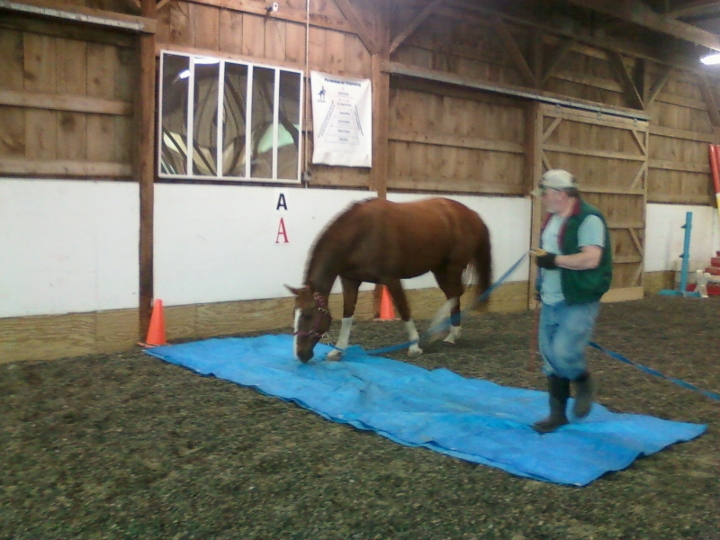 Horses spook. It's part of their nature and what helps this large prey species survive in a world full of horse eating predators.
Horses spook. It's part of their nature and what helps this large prey species survive in a world full of horse eating predators.Unfortunately, when we are riding the horse, they also tend to spook at things that really don't strike us humans as being worth giving a glance at, let alone turning tail and running away from!
Things that can fall into this "What!? Are you kidding me!?" category include scraps of paper, leaves floating in the wind, sparrows, shadows, and reflections. More understandable spook causers are falling tree limbs, dark potentially deep puddles, mountain lions suddenly appearing out of nowhere (or, yes, a kitten), and blue tarps.
Yes. Those very popular blue woven polyethylene coated all purpose lightweight tarps. With their easy movement in the breeze, their crunchy noisy texture, and their bright blue sheen, they can truly make a horse very worried very quickly.
And so, accordingly, blue tarps make for really good training tools with horses both young and old.
This past week, while doing groundwork with one of our younger horses, we brought a blue tarp into the arena. This was her first encounter with it. And even though it was quite some distance away, she snorted and was on Ultra High Alert. But with a little help and guidance, she soon discovered it was not going to kill her.
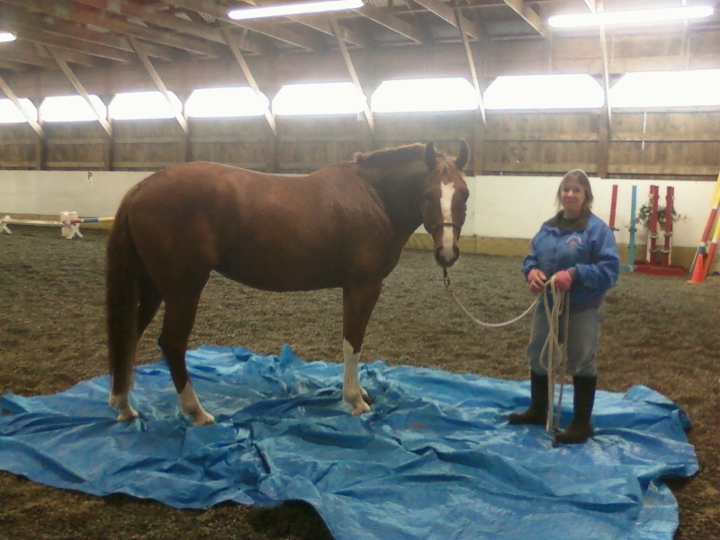 In some trail classes, blue tarps are part of the obstacle course. I would speculate that a true good working horse on the range would be expected to be able to cope with tarps and so much more. And of course police horses would be trained to tarps as well. But a dressage horse?
In some trail classes, blue tarps are part of the obstacle course. I would speculate that a true good working horse on the range would be expected to be able to cope with tarps and so much more. And of course police horses would be trained to tarps as well. But a dressage horse?By nature of her breeding (Da Vinci x Bustron) and her owner's ambitions, Bea's planned future is as a dressage horse. So this young mare is not likely to have to perform over or even near blue tarps. At least, that is what one would expect. (Never say never.)
Tarp training goes beyond showing off, having a horse standing on or even UNDER a tarp. It works on the general relationship of horse and handler. It gets us closer to being able to tell the horse something is safe and having them believe us. The tarp training helps the horse develop mentally while also encouraging their natural curiosity in a safe training environment.
And actually, it is good fun! All good things. :-)
 This is not a problem we encounter on the farm. No, if we have a dinner party, we simply have to decide whether to add an extra picnic table.
This is not a problem we encounter on the farm. No, if we have a dinner party, we simply have to decide whether to add an extra picnic table.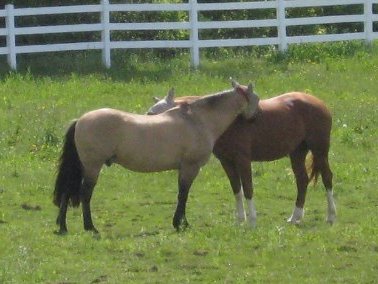 At first, things went just fine. However, within a short amount of time, the big youngster was no longer interested in the retired mare. Instead, he was more interested in a big young gelding on the other side of the fence with two other geldings. All day long, the two big youngsters would play fight, pull off each other's fly masks, and ignore anyone who wanted to bring them in for the night! The two horses bonded over the fence.
At first, things went just fine. However, within a short amount of time, the big youngster was no longer interested in the retired mare. Instead, he was more interested in a big young gelding on the other side of the fence with two other geldings. All day long, the two big youngsters would play fight, pull off each other's fly masks, and ignore anyone who wanted to bring them in for the night! The two horses bonded over the fence. In August, we saw Tropical Storm Irene. We suffered no damage here, thank goodness. We were very lucky and only had a strong summer rainstorm. Can't say the same for our neighbors in Vermont, however! Yikes!
In August, we saw Tropical Storm Irene. We suffered no damage here, thank goodness. We were very lucky and only had a strong summer rainstorm. Can't say the same for our neighbors in Vermont, however! Yikes! 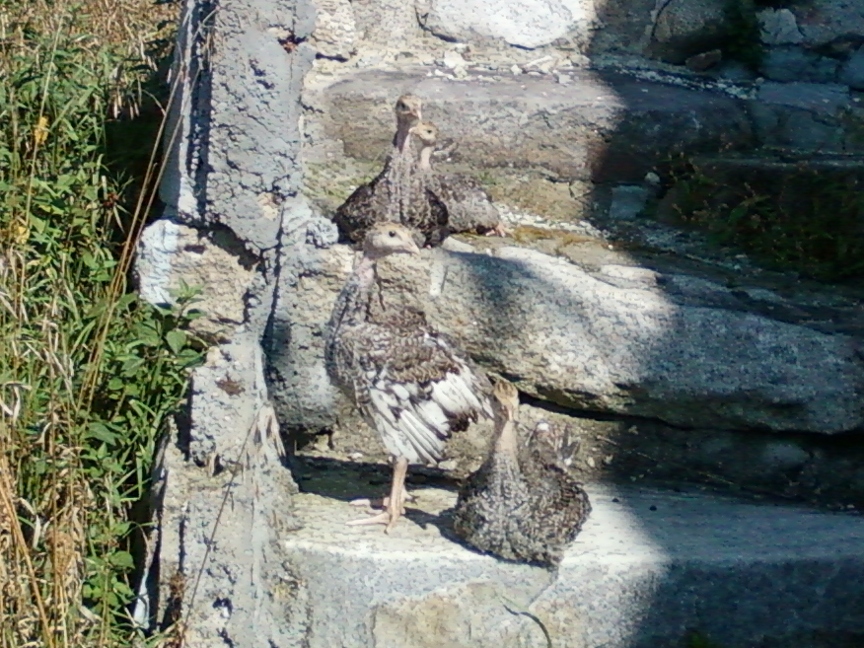 Meanwhile, as time continues to march on, we're finally seeing wonderful growth in our Thanksgiving turkeys. We purchased our lovely Bronze Turkey poults in late July. It was not until October that we started to believe they would be more than "rock cornish game hens" by TG. Now, the difference in their size, week by week, is truly evident. They will be good sized in time for "the end".
Meanwhile, as time continues to march on, we're finally seeing wonderful growth in our Thanksgiving turkeys. We purchased our lovely Bronze Turkey poults in late July. It was not until October that we started to believe they would be more than "rock cornish game hens" by TG. Now, the difference in their size, week by week, is truly evident. They will be good sized in time for "the end". When done, the mixture has a pleasant consistency which is easy to apply on the legs. Since we use the tropical green No-Ad Aloe After Sun Gel, the final mixture is a very appetizing pale green in color, kind of like Key Lime Pie. So don't leave it on the kitchen counter!
When done, the mixture has a pleasant consistency which is easy to apply on the legs. Since we use the tropical green No-Ad Aloe After Sun Gel, the final mixture is a very appetizing pale green in color, kind of like Key Lime Pie. So don't leave it on the kitchen counter!
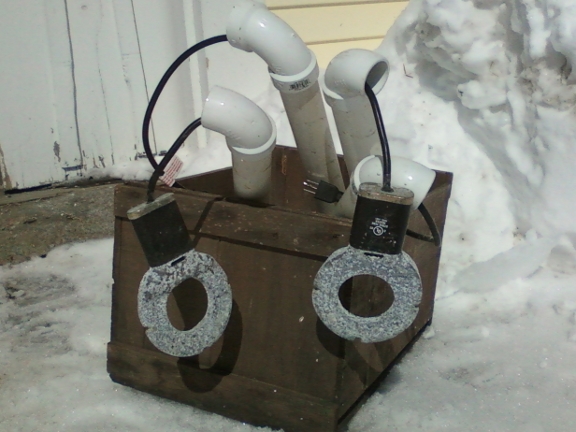 For the aeration system to work, more air would need to be used, which means more power, more electricity, more costs! And the motion of the water would probably be so intense that the horses would not want to drink from it anyway. And there is the question of whether they would drink the water if it were colder than a slush puppy?
For the aeration system to work, more air would need to be used, which means more power, more electricity, more costs! And the motion of the water would probably be so intense that the horses would not want to drink from it anyway. And there is the question of whether they would drink the water if it were colder than a slush puppy? ....the warm weather was immediately followed by a wicked cold snap with temps dropping back into the single digits at night. During the transition from practically balmy weather to downright artic weather, I failed to take the little de-icer off the timer. Sure enough, it became imbedded in a couple inches of ice at the bottom of a trough. It took a long time before it was able to free itself clear of the ice and start working on the water again.
....the warm weather was immediately followed by a wicked cold snap with temps dropping back into the single digits at night. During the transition from practically balmy weather to downright artic weather, I failed to take the little de-icer off the timer. Sure enough, it became imbedded in a couple inches of ice at the bottom of a trough. It took a long time before it was able to free itself clear of the ice and start working on the water again.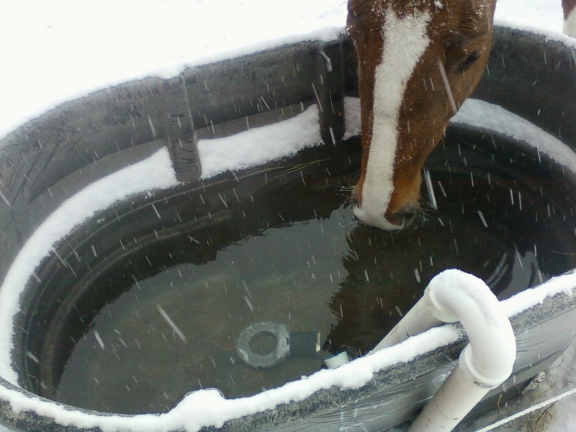 Plan B - Continuous Movement Through ..... TBD
Plan B - Continuous Movement Through ..... TBD 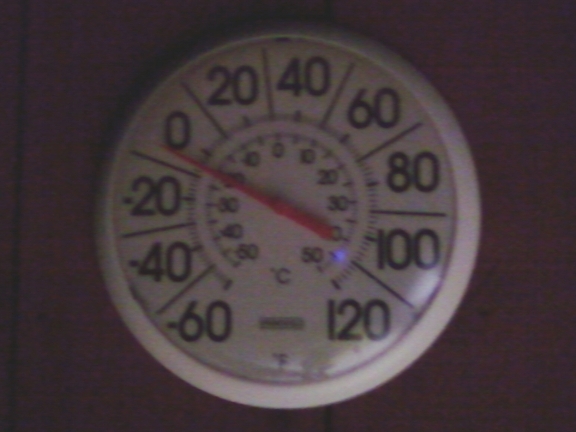 After a relatively mild December, January has really provided a very sharp reminder of just how cold and snowy it can get in New Hampshire! And February is already looking to be just as wintery!
After a relatively mild December, January has really provided a very sharp reminder of just how cold and snowy it can get in New Hampshire! And February is already looking to be just as wintery!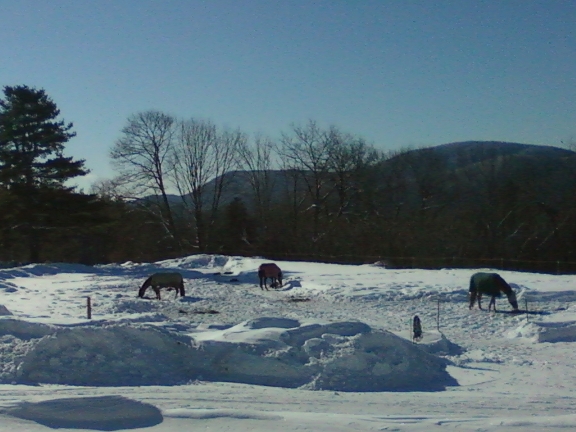 Since we plow the pastures, the horses always have space to "graze" on their hay without stomping through deep snow. But even providing that luxury may become a challenge as the storms keep rolling in.
Since we plow the pastures, the horses always have space to "graze" on their hay without stomping through deep snow. But even providing that luxury may become a challenge as the storms keep rolling in.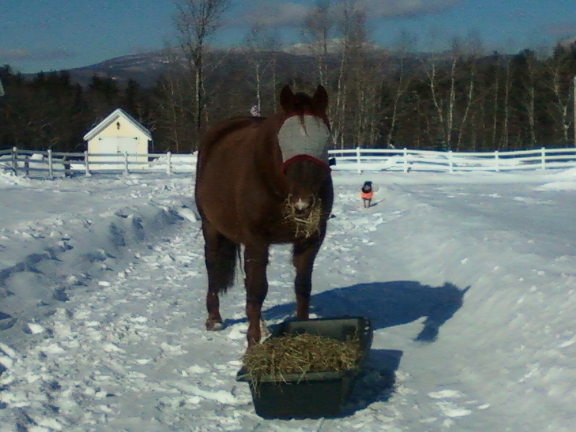 It may have been a serious fashion faux pas, but it worked surprisingly well. My eyes were sufficiently protected. Watch. Flymasks will be all the rage next winter, on horses AND their owners! :-)
It may have been a serious fashion faux pas, but it worked surprisingly well. My eyes were sufficiently protected. Watch. Flymasks will be all the rage next winter, on horses AND their owners! :-) 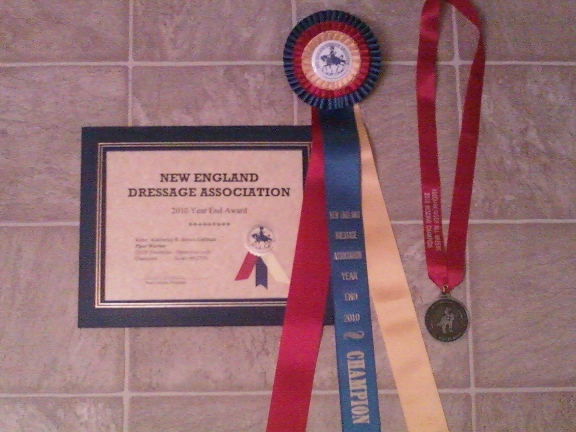 By the end of 2010, Kearsarge Meadows lesson horse Piper Warrior and farm owner Kimberley had achieved their 2010 dressage goals, and then some. They made it to the 2010 USDF Region 8 Championships in 3 categories! And they finished 2010 with several National & New England Dressage Association (NEDA) year end awards, including:
By the end of 2010, Kearsarge Meadows lesson horse Piper Warrior and farm owner Kimberley had achieved their 2010 dressage goals, and then some. They made it to the 2010 USDF Region 8 Championships in 3 categories! And they finished 2010 with several National & New England Dressage Association (NEDA) year end awards, including: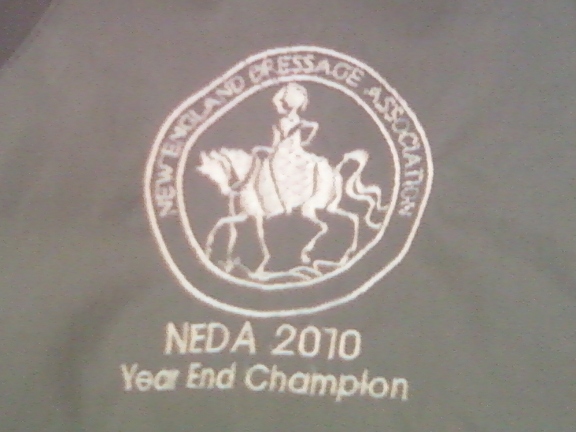 The 2010 NEDA Year End Championship for USDF Freestyles came with a massive championship ribbon and a gorgeous embroidered Mountain Horse jacket. Very nice!
The 2010 NEDA Year End Championship for USDF Freestyles came with a massive championship ribbon and a gorgeous embroidered Mountain Horse jacket. Very nice!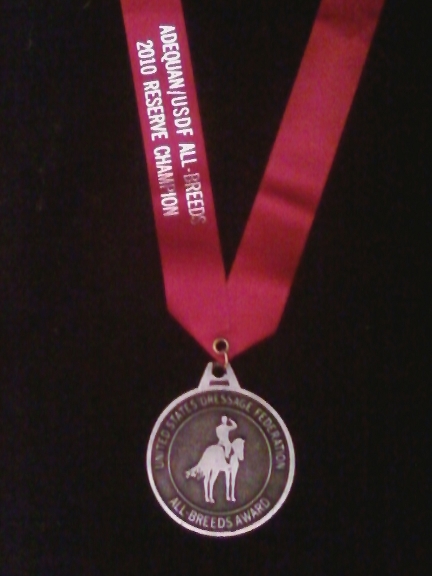 Anyone looking at Piper this morning would find it a little difficult to imagine the woolly black warmblood ready to compete again in four months time, but that is part of this year's game plan. Well, that's only if he does not sell before then. (Click here to view
Anyone looking at Piper this morning would find it a little difficult to imagine the woolly black warmblood ready to compete again in four months time, but that is part of this year's game plan. Well, that's only if he does not sell before then. (Click here to view  Trail Riding vs Hunting
Trail Riding vs Hunting  Winter is a great time to work on submission, suppleness, and lateral work. Since we allow our horses to develop their natural heavy winter coats, when we train, we do so in such a way as to avoid them getting sweaty and overheated. Cooling down a hot, wet, heavy coated horse is not easy nor fun.
Winter is a great time to work on submission, suppleness, and lateral work. Since we allow our horses to develop their natural heavy winter coats, when we train, we do so in such a way as to avoid them getting sweaty and overheated. Cooling down a hot, wet, heavy coated horse is not easy nor fun.